Chimpanzees or Chimps are native to sub-Saharan Africa. They adapt to all kinds of conditions and can be found thriving in rainforest, montane forests, dry savanna grasslands and swamps. Chimpanzees belong to the great ape family which include gorillas and Orangutans. Chimpanzees are divided into two species – The Common Chimp and the Bonobo (pygmy chimpanzee). The Common Chimp is divided into 4 sub-populations – The central chimp, the Nigeria-Cameroon Chimp, eastern chimp and western chimp.
Chimpanzees and bonobos are the closest relatives to humans. Biologists believe that chimps, bonobos and humans share a common ancestor who lived about 7 million years ago. They further believe that Chimps and bonobos separated about 1 million years ago. Bonobos are restricted to DRC (Democratic Republic of Congo).
Physical Characteristics
Chimpanzees generally have a bare face, palms, toes and fingers. They are covered by either brown or black coats. Common Chimps are larger than bonobos. Females can weigh between 27 to 50 kilograms 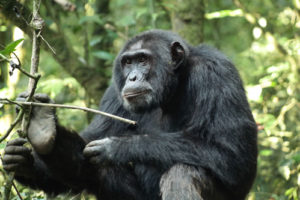 while males weigh up to 70 kilograms. Although they weigh less than humans, chimps are 1.5 time stronger physically. An adult chimp can stand upright reaching a height of about 4 feet and 11 inches. They can move on both four legs or upright with arms that are longer than legs. The average lifespan of wild chimpanzees is short. Most reach 25 years while a few can live for 60 years. Chimps in captivity live longer with some reaching 70 years. As they age, chimps develop grey hair around the chin or develop bald spots.
while males weigh up to 70 kilograms. Although they weigh less than humans, chimps are 1.5 time stronger physically. An adult chimp can stand upright reaching a height of about 4 feet and 11 inches. They can move on both four legs or upright with arms that are longer than legs. The average lifespan of wild chimpanzees is short. Most reach 25 years while a few can live for 60 years. Chimps in captivity live longer with some reaching 70 years. As they age, chimps develop grey hair around the chin or develop bald spots.
Feeding and Diet
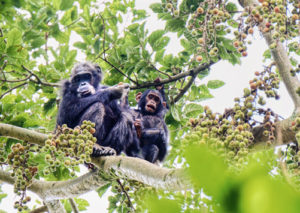 Chimpanzees spend their time on the ground and also on tree tops. They start the day at dawn and head straight to areas known to have the best food. Chimps are skillful climbers and use their arms to jump or swing from tree to tree. Most feeding is done on tree tops but they also spend time foraging on the ground. After feeding, chimps enjoy taking an afternoon nap. Chimp diet consists of mainly fruits, stems, bark, leaves, seeds and blossoms. Though mostly herbivorous, chimps also eat insects, soil, honey and birds. Chimps have been observed hunting down other smaller primates and antelopes for food. Their commonest prey are small baboons, colobus monkeys, bushbucks, bush babies, warthogs and blue duikers. They succeed in this by ganging up and forming effective hunting parties. It is important to note that meat and insects only make up 2 percent of chimpanzee diet.
Chimpanzees spend their time on the ground and also on tree tops. They start the day at dawn and head straight to areas known to have the best food. Chimps are skillful climbers and use their arms to jump or swing from tree to tree. Most feeding is done on tree tops but they also spend time foraging on the ground. After feeding, chimps enjoy taking an afternoon nap. Chimp diet consists of mainly fruits, stems, bark, leaves, seeds and blossoms. Though mostly herbivorous, chimps also eat insects, soil, honey and birds. Chimps have been observed hunting down other smaller primates and antelopes for food. Their commonest prey are small baboons, colobus monkeys, bushbucks, bush babies, warthogs and blue duikers. They succeed in this by ganging up and forming effective hunting parties. It is important to note that meat and insects only make up 2 percent of chimpanzee diet.
Intelligence
After humans, Chimps are the most intelligent of primates. They are capable of using various tools for different purposes. These tools are made by modifying rocks, sticks or grass and using them to force 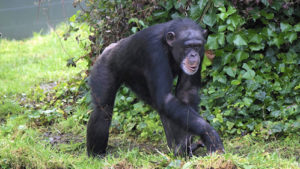 termites/insects out of their mounds or spear smaller mammals. They have also been observed soaking up water to drink using leaf-sponges or opening up nuts using stones.
termites/insects out of their mounds or spear smaller mammals. They have also been observed soaking up water to drink using leaf-sponges or opening up nuts using stones.
Apart from using tools, chimps display other signs of intelligence including the ability to remember symbols and cooperating when doing tasks or hunting. Chimps have self-awareness and are one of the few pests known to pass the mirror test. Other marks of intelligence are an ability to laugh, tickle each other and care for a dying member of the group
Social Life
Chimps are extremely social compared to gorillas or any of the other great apes. They demonstrate complex social strategies and behavior which are similar to humans. Chimps know how to create coalitions, take advantage of opportunities for their own individual benefit, hide information that could benefit others or use deceptive body language. Chimp communities are highly political just like you would see with humans. Chimp communities can consist of between 15 to 150 individuals. Individuals may form smaller groups to feed, hunt or patrol their common territory. Although chimps in a community split to form smaller groups, they all know each other. They will get together to defend their common territory.
Chimp communities are often led by several males with the dominant male yielding more power. The males in the group share responsibility of protecting the group, searching for food and patrolling the territory. Unlike gorilla groups, dominant male chimps do not yield absolute power. This is because chimpanzee communities are large and unstable. The leading male must continuously assert himself every time the splinter groups rejoin the main group. His reign can easily end if the other males in the group combine to expel him out of the group. It is important for the dominant male to maintain coalitions in order to contain the main competitors.
Note: Chimpanzees build a nest in a new location every night. Every chimp makes its own nest except for mothers and their infants.
Communication
Chimps use different sounds to communicate with each other. These sounds are accompanied by special postures and facial expressions. For example, a frightened chimp will display a special grin to alert 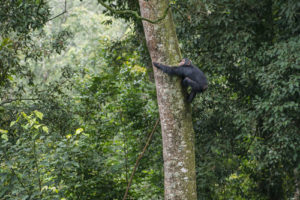 others. Chimps may also sneer, extend a hand, crunch or swagger to send a special message. Other methods of communication include beating tree trunks or drumming. This method of drumming and beating tree trunks is commonly seen when they encounter another community or leopards. Chimps are experts at vocalization as a form of communication. Hooting, barking and grunting is used for bonding, when greeting or feeding. One of the things that make chimpanzee trekking interesting compared to watching gorillas is that chimps are very vocal. The loud noises and commotion within chimpanzee groups makes it is easy to locate them even before seeing them.
others. Chimps may also sneer, extend a hand, crunch or swagger to send a special message. Other methods of communication include beating tree trunks or drumming. This method of drumming and beating tree trunks is commonly seen when they encounter another community or leopards. Chimps are experts at vocalization as a form of communication. Hooting, barking and grunting is used for bonding, when greeting or feeding. One of the things that make chimpanzee trekking interesting compared to watching gorillas is that chimps are very vocal. The loud noises and commotion within chimpanzee groups makes it is easy to locate them even before seeing them.
Mating
Female chimpanzees will reach sexual maturity at 13 years while males at 16. Males generally remain with their community for the rest of their lives but females will leave to join other chimpanzee communities. Unlike males who are ready to mate at any time of the year, female chimps are more open to copulation when they come into oestrus. Oestrus occurs once a month and lasts between 10 to 14 days. To show that they are fertile, female chimps will exhibit a pink swelling on their behinds. Actual mating is a brief affair lasting between 6 to 7 seconds. Unlike gorillas, the dominant chimp doesn’t have sole mating rights over females in the group. Female chimps can mate with several male members of the group. Unlike in gorilla groups, female chimpanzees may form a strong bond with a particular male who is not considered among the most dominant in the community. Mating with different males in the community ensures that the female has their support. It also reduces the chances of infanticide.
Once copulation is successful (this happen once every 5 years), the gestation period is 8 months. A female will give generally give birth to only one infant. Twins are possible but very rarely. A mother will bare most of the responsibility of taking care of the infant and will do so with great love and attention. An infant quickly learns how to cling on the mother’s belly after birth. At 6 months, the infant begins riding on the mothers’ back. The mother and infant will form a close bond because she takes long to give birth again. A female chimpanzee has all the time to be the best mother. She will teach the infant the required skills to survive in the jungle, protect it from other members of the community and offer emotional support. After one year, the infant will start developing closer relationships with other members of the community. If a mother dies or is injured, other females in the community will act as caregivers. The infant is weaned once they are 6 to 9 years old. Mother chimp will develop a lifelong bond with the son unlike with daughter. You may want to read more about gorilla mating patterns.
Aggressiveness and attacks
Chimps are more aggressive than gorillas. This is more so because chimpanzee males often gang up and plan deadly raids to other chimp communities. Because of the instability in chimp groups and communities, there are constant fights to establish dominance. These fights are often brutal and end in death. Chimpanzees are also known to attack human communities living close to their territories. They often target children and are capable of kidnapping human babies. Chimpanzees are generally much more unpredictable and aggressive compared to gorillas. In areas where chimpanzees share habitat with gorillas, they can be observed feeding in the same tree. They rarely compete for food and will simply ignore each other. However, given the aggressive nature of chimps, they have also been observed ganging up to attack a gorilla family.
Conservation
There was a time when over 1 million chimps roamed the dense forests and savanna of Africa. Now less than 300,000 individuals remain in the wild. Their rapidly declining number has forced the 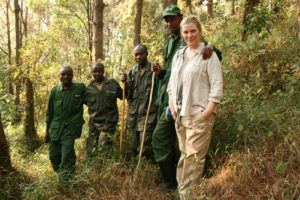 International Union for Conservation of Nature (IUCN) to list them as critically endangered. Leopards are their main natural chimp killers but lions have also been observed killing savanna chimps. Leopards and Lions aside, humans are the greatest threat to chimps. The human threat comes in form of diseases, habitat loss and poaching. Poaching is often done for meat and to satisfy the demands of pet traders or Circus organizations. Chimpanzees are also caught in snares left behind by poachers to trap other forest mammals and birds. These snares can maim chimps leading to amputations of body parts or death. Chimps are also used in laboratories for research purposes as clearly seen during the recent Coronavirus research initiatives.
International Union for Conservation of Nature (IUCN) to list them as critically endangered. Leopards are their main natural chimp killers but lions have also been observed killing savanna chimps. Leopards and Lions aside, humans are the greatest threat to chimps. The human threat comes in form of diseases, habitat loss and poaching. Poaching is often done for meat and to satisfy the demands of pet traders or Circus organizations. Chimpanzees are also caught in snares left behind by poachers to trap other forest mammals and birds. These snares can maim chimps leading to amputations of body parts or death. Chimps are also used in laboratories for research purposes as clearly seen during the recent Coronavirus research initiatives.
Organizations like the African Wildlife Foundation (AWF), Jane Goodall Institute and World Wide Fund for Nature (WWF) are working tirelessly to protect chimpanzees in Africa. World Wide Fund for Nature is helping by monitoring chimp populations, helping establish and manage national parks, involving communities to sustain forests in chimpanzee territory and encouraging countries to form partnerships for protecting the primates. African Wildlife Foundation on the other hand works closely with 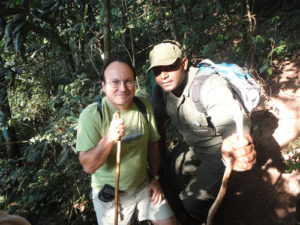 communities living close to chimpanzee habitat by providing incentives that would encourage them to see the benefits of keeping chimps for posterity. They have built conservation centers like Lupani School were young people are taught about the importance of protecting chimps and other wildlife.
communities living close to chimpanzee habitat by providing incentives that would encourage them to see the benefits of keeping chimps for posterity. They have built conservation centers like Lupani School were young people are taught about the importance of protecting chimps and other wildlife.
How can you help as an individual? The best way to help with Chimpanzee Conservation is by donating to Organizations like the WWF or visiting chimpanzees in the wilds of Africa. Tourism has helped a lot in promoting primate conservation. From tourism, money is raised to patrol chimpanzee habitats, build the required infrastructure and paying staff required to protect the primates. When a community benefits from tourism, they are less likely to harm the chimps or destroy their habitat. Tourists also help spread the gospel of primate conservation as seen with mountain gorillas. Many believe that mountain gorillas would probably be extinct if it weren’t for tourism.
Where to see Chimpanzees
The central chimpanzee is the most widespread with over 110,000 individuals living in mainly Angola, Congo, Gabon, Cameroon, Nigeria, Equatorial Guinea and Central African Republic. The eastern chimpanzees are found in the Central African Republic, Uganda, Rwanda, Tanzania, South Sudan and 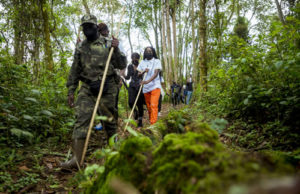 the Democratic Republic of Congo. Western chimpanzees can be found in Senegal, Nigeria, Côte D’Ivoire, Guinea, Ghana, Senegal, Guinea-Bissau, Mali, Liberia and Sierra Leone. The least numerous species are the Nigeria-Cameroon chimpanzee consisting of about 6,400 individuals.
the Democratic Republic of Congo. Western chimpanzees can be found in Senegal, Nigeria, Côte D’Ivoire, Guinea, Ghana, Senegal, Guinea-Bissau, Mali, Liberia and Sierra Leone. The least numerous species are the Nigeria-Cameroon chimpanzee consisting of about 6,400 individuals.
The best countries to observe chimpanzees in the wild are Uganda, Tanzania, the Democratic Republic of Congo and Rwanda. Chimpanzee Trekking in Kibale National Park is particularly popular. But you can so consider chimpanzee tracking in Nyungwe National Park or Virunga National Park in Congo. We have a great article about chimpanzee tracking in Tanzania. The Ngamba Chimpanzee Sanctuary in Uganda welcomes volunteers and those who are interested in witnessing what is being done to protect chimp. Uganda offers more variety than any other chimpanzee trekking destination. Tourists can also track chimps in Budongo forest of Murchison Falls National Park, Kalinzu forest, Semuliki National Park, Maramagambo forest and Kyambura Gorge of Queen Elizabeth National Park. There is an age limit for Chimpanzee trekking that you need to be aware of and it depends on where you wish to see them.

